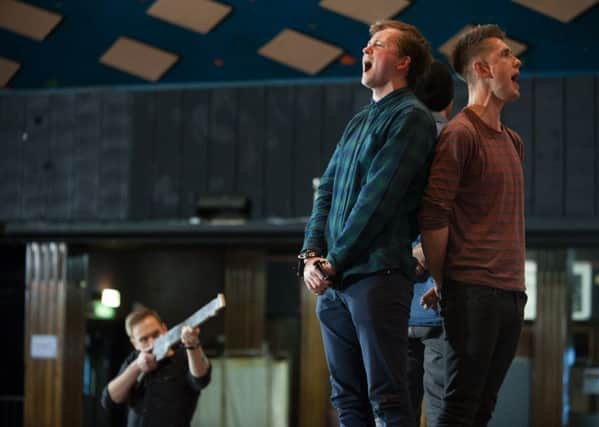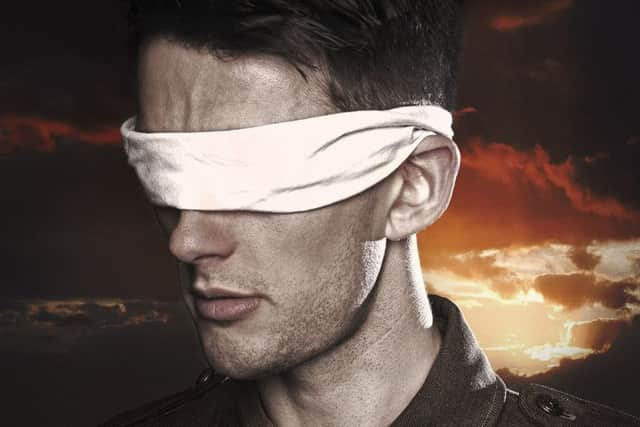The 306: Dawn, the play that honours First World War soldiers shot for desertion


In the hours before dawn, next Saturday morning, bleary-eyed theatre-goers will converge on a barn in Perthshire. While other performances of National Theatre of Scotland’s ambitious new site-specific show, The 306: Dawn, will take place at a more civilised hour, the official opening is at first light, for a very particular reason.
Soldiers sentenced to death for cowardice or desertion in the First World War were shot at dawn, often having been kept overnight in barns or farm buildings. A total of 306 men died this way in the first two years of the war shot by firing squads often drawn from their own battalions (after 1916, casualties were so high that executions came to an end). The 306: Dawn is the first of a trilogy of plays, created by writer Oliver Emanuel and composer Gareth Williams, which tells the story of these men, and the long battle by their descendants to have them pardoned which finally ended in 2006.
Advertisement
Hide AdIn the dim half-light of the Barrowland, the team behind The 306 are slowly but surely turning the first part of this story into a piece of theatre. The ballroom, a nearly exact match in size for the barn at Dalcrue Farm, now houses a replica of Becky Minto’s set, a network of raised platforms with wedge-shaped phalanxes of seating between them. The audience will be able to see the action happening around and above them on a scaffold.


“We wanted the audience to feel that it’s all around them, which I guess war is,” says Minto, a veteran of site-specific performances, including White Gold at the Sugar Sheds in Greenock. She also worked on the opening and closing ceremonies of the Commonwealth Games.
“We realised we couldn’t recreate the First World War – you could never do it justice. But ultimately, we have gone back to historical accuracy within the setting, so the actual ground plan is a plan of a trench in the Somme; the duckboards that divide the spaces are being built to military specifications. The performance platforms will be at eye-height for the audience, as if they were looking over the top of a trench. We’re trying to create a space where a 21st-century audience can reflect on what happened.”
The 306: Dawn, funded as part of 14-18 NOW, the cultural programme set up around the centenary of the Great War, follows three true stories: Glasgow lad Joseph Byers, 17, who lied about his age to enlist, and was shot two months later after trying to escape from the Front; Harry Farr, who was convicted of cowardice after suffering from shell-shock; and Lance-Sergeant Joseph “Willie” Stones, who was accused of casting away his arms in combat and leaving the front line, which seems at best to have been a misunderstanding of the actions of a good and trustworthy soldier. Like all the 306, their names were excluded from war memorials and their families denied war pensions.
Oliver Emanuel, an award-winning writer who is being hailed as one of Scotland’s most promising young playwrights after his work on projects such as Vox Motus’s Dragon, says: “The story challenges what we think about the war and how we memorialise the dead. Gareth and I were looking at all the planned memorials for the First World War. It felt like all the stories were about bravery and sacrifice and heroism. It seemed as if there was something missing. What about those who failed to live up to this ideal? When we found out about the 306, it was an instant connection.”


Even as late as 1993, John Major told parliament that pardoning the 306 would be an insult to those who died valiantly. Those campaigning on their behalf contended that some trials had not been fair, and the punishments not uniform. Of 20,000 men found guilty of capital offences, only 306 were executed. Laurie Sansom, artistic director of NTS, who commissioned the play and will direct it, says: “The men who collapsed, broke down psychologically, ran away in fear, or suffered miscarriages of justice – many of them were as much victims of the war as the people who were killed in combat. It was so arbitrary. A man who could have won a medal for bravery one day could have been the man who broke down and couldn’t go over the top the next day.”
Advertisement
Hide AdHe spoke of stories which have gone untold in the larger story of horror: the trauma suffered by the men on firing squads; victims who suffered prolonged, messy deaths when their comrades shot to miss. In the ensemble, the same men will play soldiers of all ranks, playing firing squad and victims.
Sansom says: “I kept asking myself, what’s the function of a piece of drama if you already know the story? We already know these three men are going to be shot. I felt the function is for the audience to bear witness, and to remember three of these men who were not allowed to be remembered.”
Advertisement
Hide Ad“Both Oliver and I asked ourselves, which would we have been, the hero or the coward,” says Williams, as Sansom hurries off for “a conversation about guns”. “I hope that this piece allows people to think about that.”
With its military setting, largely male cast and site-specific dynamic, the show is bound to prompt comparisons to Black Watch, Gregory Burke’s tale of contemporary soldiers, which became a huge round-the-world hit for NTS. In fact, The 306: Dawn is a very different animal, more elegiac and contemplative, though still packing a punch.
Williams, who is composer in residence at Scottish Opera, said he found it hard at times to write the music for a story that was so “unbearably sad”. He and Emanuel tried out various options as they looked for the right musical milieu for the show, including a session singing “bawdy trench songs” round the piano, before hitting on a haunting contemporary score with an edge: the majority of the cast are not classically trained singers, so there is the rawness of “real” voices.
“We were always very sure that the words weren’t serving the music or vice versa, we wanted to find a nice balance. We talked for a long time about theatre, opera, music theatre, musical theatre, what the defining features are of each one. I guess we didn’t want to make any one of those things.
“I wanted the music to feel like the present day, reflecting back 100 years, so it’s slightly more abstracted and stylised, but tied together with little things like whistles and harmonicas, the sounds of the trenches.”
When he visited the barn at Dalcrue Farm, a modern space which was used until recently for dog agility training, Williams was pleasantly surprised. “I’ve staged operas in pubs and lighthouses, but this is one of the most ambitious and strange venues I’ve come across. I walked about the place blowing my harmonica and singing and clapping, and it actually has a really good acoustic, the sound reverberates really well. It was a really lucky find.”
• The 306: Dawn, Dalcrue Farm, Perthshire, Tuesday-11 June, www.nationaltheatrescotland.com